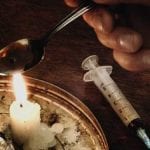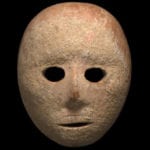 Weird Stuff
Weird Stuff  Weird Stuff
Weird Stuff  Animals
Animals 10 Inspiring Tales of Horses Being Human
 Mysteries
Mysteries Top 10 Haunting Facts About the Ghost Ship MV Alta
 History
History 10 Surprising Stories About the Texas Rangers
 Humans
Humans 10 Philosophers Who Were Driven Mad by Their Own Theories
 Miscellaneous
Miscellaneous 10 Video-Game-Worthy Weapons and Armors from History
 Weird Stuff
Weird Stuff 10 Psychics Who Accurately Predicted Wartime Events
 The Arts
The Arts 10 Pieces of Art Inspired by a Broken Heart
 Health
Health 10 Science Fiction-Sounding New Medical Treatments
 History
History 10 Surprising Facts About the Father of Submarine Warfare
 Weird Stuff
Weird Stuff 10 Times Real Laws Were Based on Bizarre Hypotheticals
 Animals
Animals 10 Inspiring Tales of Horses Being Human
 Mysteries
Mysteries Top 10 Haunting Facts About the Ghost Ship MV Alta
Who's Behind Listverse?

Jamie Frater
Head Editor
Jamie founded Listverse due to an insatiable desire to share fascinating, obscure, and bizarre facts. He has been a guest speaker on numerous national radio and television stations and is a five time published author.
More About Us History
History 10 Surprising Stories About the Texas Rangers
 Humans
Humans 10 Philosophers Who Were Driven Mad by Their Own Theories
 Miscellaneous
Miscellaneous 10 Video-Game-Worthy Weapons and Armors from History
 Weird Stuff
Weird Stuff 10 Psychics Who Accurately Predicted Wartime Events
 The Arts
The Arts 10 Pieces of Art Inspired by a Broken Heart
 Health
Health 10 Science Fiction-Sounding New Medical Treatments
 History
History 10 Surprising Facts About the Father of Submarine Warfare
10 Secrets Of Ancient Medicine
Over millennia, we developed a complex and nuanced pharmacopoeia to deal with our ailments. Today, modern medicine is beginning to embrace these ancient cures. Researchers and archaeologists are working tirelessly discover these age-old remedies and develop new treatments from time-tested medicine.
10Anglo-Saxon Eye Salve

In 2015, scientists recreated a ninth-century Anglo-Saxon treatment for eye infections. Composed of onion, garlic, wine, and cow bile, the ancient salve flabbergasted researchers by effectively combating methicillin-resistant Staphylococcus aureus—or MRSA. Discovered in an ancient medicinal text called Bald’s Leechbook, the salve could be the key in combating antibiotic-resistant super-bugs. Researchers discovered that the ancient salve killed 90 percent of MRSA bacteria cultures. They do not believe one ingredient is the key but rather the entire concoction’s antibiotic properties.
Bald’s Leechbook is one of the earliest examples of a medical textbook. Researchers believe the Anglo-Saxons practiced something similar to the scientific method with an emphasis on observation and experimentation. Scientists were blown away to discover that people were carrying on detailed studies of infection centuries before the discovery of microbes. Researchers believe there are many other ancient texts with treatments for what appear to be bacterial infections.
91300-Year-Old Pharmaceutical Operation

Between 2013 and 2015, Turkish archaeologists discovered 700 small bottles containing ancient antidepressants and heart disease drugs. Unearthed during excavations of Bathonea on Kucukcekmece Lake, the unguentaria bottles were found along with pestles, mortars, and a large cooker, suggesting this was the site of a massive ancient pharmaceutical operation. It is the largest number of bottles ever discovered at a single archaeological site.
Researchers were first alerted to the potential for ancient pharmaceuticals due to the presence of medicinal plants growing in the site. Analysis revealed the unguentaria contained methanone and phenanthrene, which are antidepressant and heart drugs respectively. Both were made from local plants. The bottles were discovered under a fire layer dating between 620 and 640, which may be evidence of the Avar invasion. While historical records mention the onslaught, this would be the first archaeological evidence of the Avar invasion in 626.
8Smoked Henbane Seeds

In 2015, archaeologists discovered evidence of medicinal henbane seed usage during excavations of Kaman-Kalehoyuk in Turkey. Eurasian henbane (Hyoscyamus niger) contains atropine and scopolamine—both of which are concentrated in the seeds. For millennia, these seeds have been used in ancient remedies and magic brews. 121 charred seeds at Kaman-Kalehoyuk were found in an old hearth along with animal dung, suggesting they were fumigated. It is the first archaeological evidence of medicinal henbane use in Asia.
The Ottomans referred to henbane as beng or benc and used it to treat toothaches, earaches, eye irritations, and a slew of other maladies. A historical record from 1608 refers to a medicinal recipe composed of henbane seeds, black pepper, and opium. Located 100 kilometers south of Ankara, Kaman-Kalehoyuk has had Bronze Age, Iron Age, and Ottoman occupations. The burned henbane seeds date to the Ottoman period between the 15th and 17th century.
7Ancient Ingrown Eyelash Remedy

A Danish Egyptologists recently translated a 3,500-year-old Egyptian papyrus containing an ancient remedy for trichiasis—or ingrown eyelashes. The document lay untouched in the University of Copenhagen archives for 80 years before Sofie Schiod translated it. The ingrown eyelash remedy requires bull fat, the blood of a bat and a donkey, lizard heart and dung, pulverized pottery, the milk of a woman nursing a boy, and a touch of honey.
The papryus’s hieroglyphics read from right to left and contain images of birds, snakes, and ships. The medicinal ingredients and their quantities are listed in red ink. Black text reveals how to put the ingredients together. Schiodt’s text was broken into seven fragments roughly equivalent to one sheet of paper. The flip side of the papyrus contains a gynecological text. German researchers studying similar ancient Egyptian medicinal documents aided Schiod’s translation. Both found similar ingredients.
6Amazing Artemisinin

In 2015, Chinese chemist Tu Youyou won a Nobel Prize for his work on artemisinin—a centuries-old wormwood-derived treatment for malaria. Researchers now believe the compound could also prove effective against tuberculosis. Michigan State University microbiologist Robert Abramovich discovered that artemisinin is capable of blocking the defense mechanism employed by Mycobacterium tuberculosis.
Mycobacetrium tuberculosis requires oxygen. Our immune systems attempt to combat the infection by limiting the bacteria’s access to oxygen. When the tuberculosis bacteria are deprived of oxygen, they enter a dormant survival stage. Artemisinin blocks a molecule called heme, effectively turning off the bacteria’s oxygen sensor. This new treatment could vastly reduce the treatment window for tuberculosis, which can take up to six months in normal conditions. The extensive length of the treatment regimen is one of the hardest things about combating tuberculosis. Incomplete therapy is a major factor in the development of antibiotic strains of tuberculosis bacteria.
51000-Year-Old Hangover Cure

The Kitab-al-tabikh—or Book of Cookery—is a 1,000-year-old Middle Eastern text containing over 600 culinary and medicinal recipes. One of its most famous entries is for an ancient hangover cure. The text’s author, Ibn Sayyar Al-Warraq recommends kkishkiyya after a night of drinking. The meat, chick pea, and vegetable stew contains khask, a fermented yogurt, milk, and whey product, which alleviates the “excess heat” in the stomach and head that occur after imbibing. One can still find kkishkiyya cooked in a similar method in the Levant and northern Iraq.
Almost nothing is known of Ibn Sayyar Al-Warraq other than his death date of 961. Researchers believe that many of his recipes came from earlier works, possibly 1,000 years before the writing of Kitab Al-tabikh. The author also suggests eating cabbage before drinking, snacking between cocktails, and drinking copious water prior to eating kkishkiyya.
4Roseroot

For millennia, people have used roseroot (Rhodiola rosea) for its medicinal qualities. According to Siberian folklore, drinkers of roseroot tea can live to over 100 years. The ancient Greeks, Vikings, Caucasians, and Mongols were all enamored with it. According to the latest research, roseroot is effective in reducing moderate depression and fatigue. Its efficacy is less than conventional antidepressants like sertraline. However, its favorable benefit-to-risk ratio is much higher.
Since the 1960s, there have been nearly 200 studies on the effect of roseroot on health. For centuries, people have used to drug to combat depression, fatigue, and altitude sickness. The Vikings used it for endurance and increased strength. The ancient Chinese sent expeditions to Siberia specifically in search of the plant. Mongolian doctors use roseroot to treat cancer and tuberculosis. To this day, Central Asians believe roseroot tea is the best medicine for colds and the flu.
3Martyr Skull Bone Powder

Italian researchers have recently discovered the purposes behind mysterious holes in the skull of a 15th-century martyr. The skull was drilled to create bone powder used in the treatment of paralysis, stroke, and epilepsy. The skull contains 16 holes of various sizes and depths. Researchers believe these were made using a special trepan tool, which would have produced bone powder. In Pharmacopee universelle, French chemist Nicholas Lemery (1645–1715) reveals that skull powder drunk in water can treat illnesses of the brain.
The skull belonged to one of the Martyrs of Otranto. On August 14, 1480, after a 15-day Ottoman siege, 800 survivors were forced to convert to Islam or lose their heads. In 1771, these victims were beatified. Powdered bone derived from saints and victims of violent death was considered particularly effective in pharmacological preparations. Why this particular skull was chosen to make bone powder remains a mystery.
2Ramesseum Medical Papyri

In 1991, Egyptian and French archaeologists discovered a series of medical papyri at the Ramesseum necropolis. These ancient documents go back to the beginning of the 18th century BC and lay out priceless pharmacological knowledge of the era. The works give detailed descriptions of anatomy, diseases, and recommended treatments. The papyri are written in vertical columns of hieratic script.
Ramesseum was the mortuary temple of Ramesses II, one of the longest ruling pharaohs. Ramesses II was known for his construction of temples, buildings, and even cities. His Theban necropolis was the “cherry on top.” Papyrus III describes the eruption of a volcano, which may be Santorini, and discuss how to treat burn victims. Dated to 1700 BC, it also contains the oldest know reference to medicinal cannabis. Papyrus IV covers problems related to female anatomy. It discusses childbirth, newborns, and contraception. An outlier, Papyrus V is written in hieroglyphics.
1Amur Cork Cancer Medicine

In 2014, researchers discovered that an ancient medicine could be effective in combating pancreatic cancer. For millennia, Chinese have used the bark of the Amur cork tree (Phellodendron amurense) as a painkiller. Researchers at the University of Texas found that Amur cork extract can block cancer development pathways. Fibrotic tissue prevents drugs from reaching tumors. The amur cork inhibits scarring around the tumor, allowing drugs to reach the cancer. Researchers also discovered that Amur cork reduces inflammation in tumors through enzyme suppression.
Pancreatic cancer is particularly deadly due to its difficulty to diagnose, aggressive behavior, and resistance to conventional treatments. The best option currently available is complete surgical excision. However, only 20 percent of patients are eligible for this treatment at the time of diagnosis. Furthermore, therapeutic agents for pancreatic cancer have proven largely ineffective. Researchers are keenly aware of the need to try novel approaches to treating this insidious ailment.
Dubbed the “Indiana Jones of folk music” by TimeOut.com, Geordie McElroy has hunted spell songs, incantations, and arcane melodies for the Smithsonian, Sony Music Group, and private collectors. A leading authority on occult music, he is also the singer of LA-based band Blackwater Jukebox.








